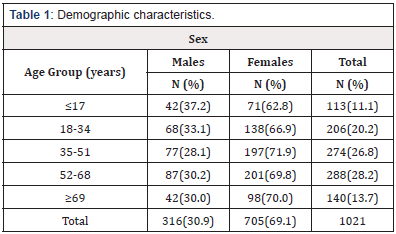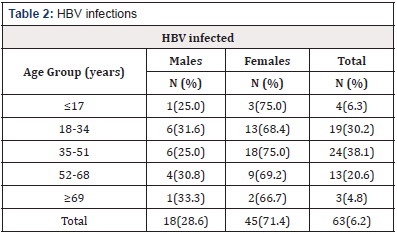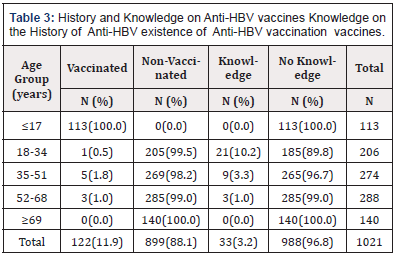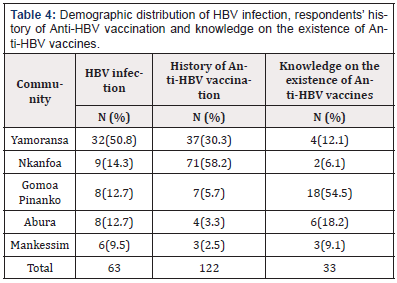Review Article 
 Creative Commons, CC-BY
Creative Commons, CC-BY
Post-vaccination epidemiological analysis of hepatitis “B” viral infection among selected communities in the Central region of Ghana
*Corresponding author: Yussuf M Dokurugu, Florida A&M University, USA.
Received: July 12, 2019; Published: July 26, 2019
DOI: 10.34297/AJBSR.2019.04.000787
Abstract
Introduction: Hepatitis B viral infection (HBV) remains a global health threat. About 257 million people currently living with HBV worldwide. HBV is prevalent in sub-Saharan Africa with prevalence of >8% established including West Africa. Though Anti-HBV vaccines existed since 1982, as the single most important Hepatitis B prevention measure. Ghana started active mass immunization program on HBV in infants in 2002 with single- combined Expanded Program Immunization (EPI) (pentavalent vaccine). However, this do not cover persons outside the EPI especially Adults. We designed this study to evaluate the impact of this vaccination programs, the accessibility of vaccines and the scope of this program in selected communities in the central region of Ghana.
Methods: We screened and evaluated 1021 respondents from five Ghanaian indigenous communities in the central region namely Nkanfoa, Mankessim, Abura, Yamoransa and Gomoa Pinanko. They were screened for HBV and evaluated for status of Anti-HBV vaccination and on knowledge on the existence of such vaccine.
Results: Majority of the respondents were between the ages of 52 years and 68 years representing 28.2% of the study population. Sixty-three (63) screened respondents tested positive to HBV infection. We recorded 6.2% HBV prevalence for the study. 11.9% had history of previous Anti- HBV vaccination whereas 33 (3.2%) had knowledge on the existence of Anti-HBV vaccines. The age class ≤17 years had all benefitted from the EPI hence were previously vaccinated. Interestingly, they all had no knowledge of such vaccines in existence. However, 4 respondents of this beneficiaries tested positive to HBV.
Conclusion: HBV is still endemic in Ghana. Despite the inception of EPI, there is still more work to be done to finally eradicate HBV from the country. EPI should be extended to benefit adults who missed the opportunity to be vaccinated from year 2002. A state of emergency should be issued on HBV and public education intensified. Easy accessibility and affordability of Anti-HBV vaccines are key in eradicating HBV from Ghana.
Keywords: Epidemiology; HBV; Anti HBV vaccine; Global health; Central region; Ghana
Introduction
Hepatitis generally results from inflammation of the liver due to varied aetiologias. However, viral hepatitis results from inflammation of the liver, caused by a viral infection [1]. Review identified almost all of such infections to five viruses, namely hepatitis A virus (HAV), hepatitis B virus (HBV), hepatitis C virus (HCV), hepatitis D virus (HDV), and hepatitis E virus (HEV) [2]. Viral Hepatitis, an infectious form of hepatitis is a major global health concern and poses severe global threats. Annually, nearly 1.4 million fatalities from viral hepatitis closely related liver cirrhosis and hepatocellular carcinomas (HCC) are recorded [3,2]. In 2015, The World Health Organization (WHO) estimated that globally, 1 in 3 people have been infected by either HBV or HCV [4] responsible for about 90% of these fatalities, whilst the remaining 10% of fatalities are caused by other hepatitis viruses [5]. In 2016, World Health Organization adopted a strategy for the elimination of viral hepatitis by 2030. This aim is to achieve a 90% reduction in new cases of chronic hepatitis B and C and 65% in mortality by 2030 [6]. Sub-Saharan Africa carries a significant portion of the global burden of viral hepatitis.
Systematic reviews indicates about 257 million people currently living with HBV worldwide [7]. In a further review by [8], a prevalence of >8% was established in parts of sub-Saharan Africa such as West Africa of which Ghana is not exempted. An intermediate prevalence (2–7.99%) is present in some regions of the eastern Mediterranean, Central Asia, Southeast Asia, parts of South America and in some European countries. A low prevalence is present (<2%) in some parts of North America in some European countries and in Australia [8]. Several reports identifies significant rates of HBV infections in Ghana which cuts across blood donors >10% [9,10], pregnant women 13.1%, rural communities 13.3% and urban communities 12.2%. Regional prevalence established the Brong Ahafo as the region with the highest rate (13.7%), the Ashanti, Greater Accra, Eastern, Northern and Central regions as 13.1, 10.6, 13.6, 13.1 and 11.5% respectively [11].
Though Anti-HBV vaccines existed and was available since 1982, as the single most important Hepatitis B prevention measure [12], Ghana started active mass immunization program on HBV in infants in 2002 with single-combined Expanded Program Immunisation (EPI) vaccine; pentavalent vaccine (DTPw-HepBHib; Panacea Biotech Ltd, India) [13]. Following 2002, several adults were vaccinated across the nation with the World Health Organization’s approved and recommended vaccine Hepavax-Gene (Berna Biotech Korea Corporation, a Crucell Company), 10 ml pediatric dose vial/ 5 ml adult dose vial [14].
For decades, these vaccination programs for adults have being adopted and taken over by health service providers in Ghana. It is common to get vaccinated as an adult in Ghana but at a fee ranging from USD 75 –USD 150 per dose. This permits only the affluent in society to access this prevention measure hence hindering the Sustainable Development Goal 3 on promoting good health and wellbeing. We designed this study to evaluate the impact of this vaccination programs, the accessibility of vaccines and the scope of this program in selected communities in the central region of Ghana.
Methods
Study Design
This community-based cross-sectional study was incorporated into an on-going medical screening program by a Ghanaian-owned rural community-focused mobile laboratory company, Dream Laboratory Consult Limited. This generated the hepatitis “B” morbidity data between 2016 and 2018. This follows decades of introduction of AntiHBV vaccination in Ghana.
Study site and population
The study was conducted in the Central region of Ghana from 2016-2018. The Central region houses a population of 2,563,228 (8.5 %) of Ghana’s 30,280,811 population, on an area of 9,826 km2 (4.1% of Ghana’s total land area of 238,533 km2) [15]. The Nkanfoa, Abura, Mankessim, Yamoransa and Gomoa Pinanko communities were recruited for this study.
Data collection
Data were collected from participants in an on-going medical screening exercise by Dream Laboratory Consult Limited in the Central region. 1021 participants were recruited for this study. Variables collected were age, sex, hepatitis “B” status, Anti-HBV vaccination status and knowledge on Anti-HBV vaccines and vaccination.
Laboratory investigation
Point of care rapid diagnostic tests on hepatitis “B” were performed. Advanced Quality TM one step hepatitis “B” surface antigen (HBsAg) Test strip for whole blood, a rapid one step immunochromatographic assay for detection of HBsAg produced InTec Products, Inc. (Xiamen).
Data analysis
Study data were collated and entered into Excel (Microsoft Office 2013) and analyzed with IBM SPSS version 20. Descriptive statistics on measured parameters were performed. Statistical reports were presented in tables.
Ethical Issues
Informed consent was sought from the participants for this study. Written permission was sought from Dream Laboratory Consult Limited, Ghana on the preparation of this manuscript and the decision to publish. The data records were also captured without traceable identities of the cases.
Results
Three hundred and sixteen (316) out of the 1021 screened respondents were males whereas 705 were females. Majority of the respondents were between the ages of 52 years and 68 years representing 28.2% of the study population (Table 1). Sixty-three (63) screened respondents tested positive to HBV infection. We recorded 6.2% HBV prevalence for the study. Females established a higher HBV infection rate than males (71.4% and 28.6% respectively) however, age group 35-51 years documented the highest HBV infection rate of 38.1% (Table 2). Among the 1021 respondents, only 122 representing 11.9% had previously received Anti-HBV vaccination whereas only 33 (3.2%) had knowledge on the existence of Anti-HBV vaccines. The age class ≤17 years had all previously received Anti-HBV vaccination (113 respondents) yet they all had no knowledge of such vaccines in existence (Table 3). Four (4) respondents representing 6.3% of this age class tested positive to HBV. The age class ≥69 years (140 respondents) all had neither been vaccinated nor heard of the existence of Anti- HBV vaccines. Stratified by communities screened, Yamoransa recorded the highest HBV infection rate of 32 out the 63 infections established (50.8%) however, Mankessim recorded the lowest number of respondents with history of Anti-HBV vaccination of 3 (2.5%). Eighteen (18) respondents representing 54.5% form Gomoa Pinanko demonstrated knowledge on the existence of Anti- HBV vaccine (Table 4).
Discussion
This study evaluated the impact of Anti-HBV vaccination programs, the accessibility to Anti-HBV vaccines and the scope of vaccination programs among selected communities in the Central region of Ghana. After nearly 2 decades of integration of Anti-HBV vaccination program into the national vaccination program, we still reported significant rate of HBV infection. Our study recorded 6.2% prevalence of HBV. This agrees with similar studies across Ghana among different respondents ranging from blood donors >10% [9,10], pregnant women 13.1%, rural communities 13.3% and urban communities 12.2% [11]. Regional prevalence established the Brong Ahafo as the region with the highest rate (13.7%), the Ashanti, Greater Accra, Eastern, Northern and Central regions as 13.1, 10.6, 13.6, 13.1 and 11.5% respectively. We observed that despite a significant rate in HBV in the region established by our study recorded a significant nearly 50% reduction which must be commended. However, further mass education and intervention programs must be designed and not be restricted to infant and children vaccination schedules. Females recorded higher HBV rate than males (71.4%). This gender difference in the infection rate is consistent with a study in Ghana [16]. They attributed these to lower socio-economic status of most females in such environments. However, on a first look it can be estimated that since most of the respondents were females (69.1%), it statistically influenced the increase in their rate (Table 1).
Due to inadequate public education on HBV, only 3.2% of the respondents had knowledge on the existence of AntiHBV vaccine. Out of 1021 respondents screened, 11.9% (122 respondents) had the opportunity to be previously vaccinated. This was strongly attributed to inadequate public information, education and the high cost of vaccine. In Ghana, free Anti-HBV vaccinations in single-combined Expanded Program on Immunization vaccine; pentavalent vaccine are only accessible by infants and children since 2002 [13]. On the other hand, although, Ghana’s Health Insurance Scheme (NHIS) introduced in 2003 aims to improve access to health services by eliminating financial barriers (commonly referred to as pay-as-you-go or pre-paid), however, HBV screening and vaccinations outside the EPI are not covered under the scheme [11]. HBV screening cost ranges from USD 2- USD 4 whereas Anti- HBV vaccination cost ranges from USD 75- USD 150. It is even more expensive to manage or treat HBV patient. The cost of oral treatment for HBV in Ghana ranges from USD 1500- USD 2000 (at GHS 5 conversion) a month or weekly. These have hampered effective control of HBV since 2002 since they favor the younger generation and the affluent class in society. This confirms our findings that all 113 respondents ≤17 years were previously vaccinated under the EPI whereas older age class ≥69 had no knowledge on the Anti- HBV vaccine and had never been vaccinated. Four (4) (6.3%) of the age class ≤17 years tested positive to HBV. Though this age class were evaluated to have been previously vaccinated under the EPI, they could be pre-exposed to HBV where were born to mothers of HBV status, mothers who have immigrated from an HBV endemic country [17]. It is, however, recommended that such infants and children be given both HBV immune globulin and the Anti-HBV vaccine in the first 12 hours of birth [17].
Yamoransa recorded the highest HBV infection rate of 32 out the 63 infections established (50.8%). This is a continuously developing community. They have no health facility of their own hence rely on nearby health facilities such as Moree Health Center, Anomabo Health Center and the Brafoyaw Medical Center. This confirms the report by [11]. They recorded a 13.3% HBV prevalence among rural communities against 12.2% in urban communities. Rural or developing communities play an integral role in HBV transmission.
Conclusion
There is a significant burden of HBV infection in the Central region. There are a huge number of adults who are still not vaccinated due different levels of inaccessibility and financial constraints. This can only be eradicated by intensified mass education, free screening programs and free vaccinations despite the EPI program. This will require a conscious effort to achieve results. It is very important for the Government of Ghana, stakeholders and all international partners to prioritize integrating free HBV screening and Anti-HBV vaccination in the national immunization program just like what is done for other viral infections such as yellow fever. Further studies should be extended to all regions to influence health policies in the country.
Acknowledgement
We wish to express our profound gratitude to the founders and staff of Dream Laboratory Consult, Ghana for their support in incorporating this study in their medical screening programs in the Central region of Ghana. We are also grateful to Young Achievers Caucus, Yale Alumni Service Corps, United States of America and Department of Medical Laboratory Science, University of Cape Coast, Department of Population and Health, University of Cape Coast and the Queen Mothers Association of Ghana (Central region branch) for making these medical screenings possible.
Funding
The authors have no support or funding to report
Competing Interests
The authors have declared that no competing interest exist.
Author Contributions
Conceived and designed the study: Yussif M Dokurugu, Evans Duah, Clement Agoni, Ransford Kumi Oduro.
Performed the Study: Evans Duah, Clement Agoni, Ransford Kumi Oduro, Richard Kobina Dadzie Ephraim Samuel Essien-Baidoo
Contributed test kits/ materials/ Analysis tools: Samuel Essien-Baidoo, Yussif M. Dokurugu, Richard Kobina Dadzie Ephraim
Analyzed the data: Evans Duah
Wrote the paper: Yussif M Dokurugu, Evans Duah
Enrolled/ recruited respondents: Evans Duah, Clement Agoni, Ransford Kumi Oduro, Samuel Essien-Baidoo
References
- WHO (2012) Prevention and Control of Viral Hepatitis Infection: Frame Work for Global Action.
- Jefferies M, Rauff B, Rashid H, Lam T, Rafiq S (2018) Update on global epidemiology of viral hepatitis and preventive strategies. World J Clin Cases 6(13): 589-599.
- WHO (2009) Viral Hepatitis.
- WHO (2018) Sixty Third World Health Assembly Viral Hepatitis (WHA63.18).
- Wiktor SZ, Hutin YJ (2016) The global burden of viral hepatitis: better estimates to guide hepatitis elimination efforts. Lancet 388(10049): 1030-1031.
- Spearman CW, Afihene M, Ally R, Apica B, Awuku Y, et al. (2017) Hepatitis B in Sub-Saharan Africa: strategies to achieve the 2030 elimination targets. Lancet Gastroenterol Hepatol 2(12): 900-909.
- WHO (2017) Hepatitis B.
- Schweitzer A, Horn J, Mikolajczyk RT, Krause G, Ott JJ (2015) Estimations of worldwide prevalence of chronic hepatitis B virus infection: a systematic review of data published between 1965 and 2013. Lancet 2015 386(10003): 1546-1555.
- Dongdem JT, Kampo S, Soyiri IN, Asebga PN, Ziem JB, et al. (2012) Prevalence of hepatitis virus infection among blood donors at the Tamale Teaching Hospital, Ghana (2009). BMC Res Notes 5:115.
- Rufai T, Mutocheluh M, Kwarteng K, Dogbe E (2014) The prevalence of hepatitis B virus E antigen among Ghanaian blood donors. Pan Afr Med J 17:53.
- Ofori-Asenso R, Agyeman AA (2016) Hepatitis B in Ghana: a systematic review & meta-analysis of prevalence studies (1995-2015). BMC Infect Dis 16: 130.
- Zanetti AR, Van Damme P, Shouval D (2008) The global impact of vaccination against hepatitis B: a historical overview. 26(49): 6266-6273.
- Sylvester Dassah, Samuel A Sakyi, Margaret T Frempong, Arnold T Luuse, Richard KD Ephraim, et al. (2015) Seroconversion of Hepatitis B vaccine in Young Children in the Kassena Nankana District of Ghana: A Cross-sectional Study. Plos ONE 10(12): e0145209.
- WHO (2014) Immunization Standards, Hepatitis B (10 paediatric dose vial/ 5 adult dose vial), Hepavax-Gene.
- GSS (2019) 2010 Population and Housing Census; July 2019 projection. Ghana Statistical Service: Accra, Ghana.
- Adjei AA, Armah HB, Gbagbo F, Ampofo WK, Quaye IK, et al. (2006) Prevalence of human immunodeffiency virus, hepatitis B virus, hepatitis C virus and syphilis among prison inmates and officers at Nsawam and Accra, Ghana. J Med Microbiol 55(Pt 5): 593-597.
- SCH (2019) Hepatitis B (HBV) in Children.







 We use cookies to ensure you get the best experience on our website.
We use cookies to ensure you get the best experience on our website.